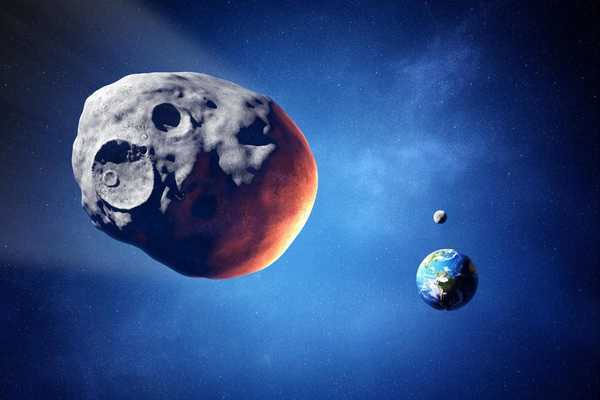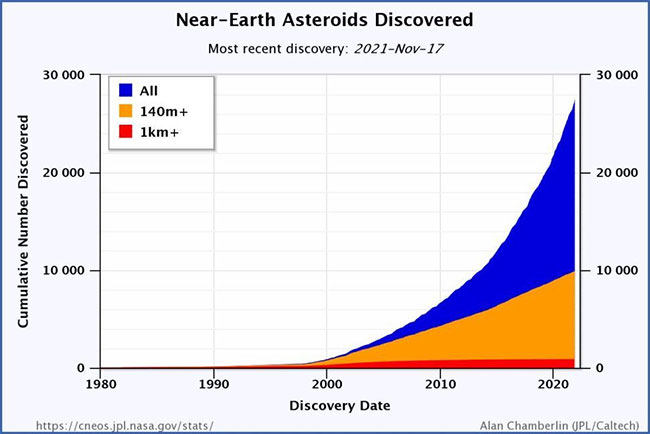How many asteroids are threatening Earth?
We often hear about an asteroid that could hit the Earth, but how many such asteroids actually threaten the Earth?
According to the US space agency (NASA) said, there is no asteroid large enough to have the ability to collide with Earth, causing significant damage to our planet in the near future.
However, so far, astrophysicists have also discovered more than 27,000 near-Earth asteroids.
"We're counting the number of asteroids that could pose a threat to Earth, but not at the moment," said Kelly Fast, director of the Near-Earth Object Observation Program at NASA's Office of Planetary Defense Coordination. Is there any asteroid that we know of that poses a significant threat to Earth'.

Currently, there are no asteroids large enough to potentially collide with Earth.
Protection of Earth from asteroid impacts has been tested by NASA and will be implemented in two phases, of which NASA's Dual Asteroid Redirection Test (DART) phase has kicked off. later this month, is a mission designed to test the second phase of Earth's defenses, which is to deflect potentially threatening asteroids to our Earth.
Before trying to redirect an asteroid, however, scientists must find the asteroid and map out its orbit for years to come to realize that it will or could hit Earth.
Nancy Chabot, an Earth scientist at the Johns Hopkins University Applied Physics Laboratory in Maryland (USA) and Head of the DART Coordinating Committee said: 'People may think, protect the Earth. is intended to deflect asteroids but it is not. Tracking actual asteroids, identifying them and finding them is really important to be able to do anything with them in the future."

Number of recently discovered near-Earth asteroids
Scientists have identified about 750,000 asteroids to date and there are millions of space rocks that cross the entire solar system, but fortunately a lot of them are very far from our Earth. .
Projects for the discovery of asteroids
The researchers used instruments on Earth and in space to detect and catalog asteroids. The majority of these discoveries have come from the late 1990s, although experts have warned of the threat posed by asteroids before, with little success.
A major milestone was the collision of Comet Shoemaker-Levy 9 with Jupiter in 1994, which unexpectedly left a trail in Earth-sized Jupiter clouds that persisted for months. That has made people start thinking about having to find a way to detect near-Earth asteroids.
Then, the US Congress stepped in with the priority of hunting for asteroids, calling on NASA to identify at least 90% of the asteroids of medium and large size. Today, there are many projects underway to detect near-Earth asteroids such as the Catalina Sky Survey project based in Arizona (USA), the Pan-STARRS observatory in Hawaii, the space telescope. NEOWISE and the ATLAS telescope.
In addition, a number of new projects will participate in the Earth protection mission such as the Vera C. Rubin Observatory in Chile starting observations in 2023; A space-based mission called NEO Surveyor is also in development and is expected to launch later this decade.
Recipe for a 'potentially dangerous asteroid'
If all of those observations detect that an asteroid exceeds a certain luminosity and will come within 7.48 million kilometers of Earth, the object will automatically be named a '. potentially dangerous asteroids'.
For space researchers, however, unidentified asteroids are far more terrifying; These asteroids are asteroids that can suddenly come close to Earth unexpectedly, too late for anyone to even try to change their course.
Scientists believe they have found almost all the largest asteroids, that is, asteroids larger than 1 km in size. As of the end of 2020, scientists have found only 40% of near-Earth objects that are less than 1km across.
While that number is impressive, NASA's planetary protection office estimates that at current rates, scientists will need another 30 years to identify 90% of objects the size of less than 1km, a goal that the US Congress asked NASA to achieve by 2020.
The mission is to map as many asteroids as possible, which is why the number of 'potentially dangerous asteroids' and near-Earth objects in general is increasing dramatically.
- 4 asteroids are threatening the Earth
- Thousands of asteroids are threatening the Earth
- Asteroids are about to fly through the earth
- Mission to bring people to asteroids
- Thousands of bombs threaten the life of the earth
- The risk of asteroids stabbing the Earth is higher than expected
- Giant asteroids do not endanger the Earth
- Four asteroids are flying past the Earth
- Identify asteroids to lead near Earth
- Earth has just escaped the 'terrorist' from 4 asteroids
- The process of shattering asteroids into the Earth's atmosphere
- NASA reveals two narrow asteroids 'swinging fists' into Earth
 Van Allen's belt and evidence that the Apollo 11 mission to the Moon was myth
Van Allen's belt and evidence that the Apollo 11 mission to the Moon was myth The levels of civilization in the universe (Kardashev scale)
The levels of civilization in the universe (Kardashev scale) Today Mars, the sun and the Earth are aligned
Today Mars, the sun and the Earth are aligned The Amazon owner announced a secret plan to build a space base for thousands of people
The Amazon owner announced a secret plan to build a space base for thousands of people